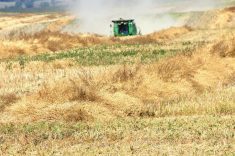Saskatchewan cattle producers who lost calves in a recent blizzard say the compensation offered by the province is not enough.
Eighty people attended a meeting in Stoughton May 10 to discuss their losses and pass a resolution requesting more than the $400 per calf minimum the government is offering through the Provincial Disaster Assistance Program (PDAP).
Hundreds of calves were trampled or died of exposure April 30-May 2 as animals tried to cope with blinding snow and wind.
However, Yogi Huyghebaert, the minister of corrections, public safety and policing who is responsible for the disaster assistance program, said the amount is not likely to change.
Read Also

Alberta researcher helps unlock the economics of farming
Lethbridge Polytechnic researcher helping agriculture producers with decision-making tools in economic feasibility
He said PDAP exists to help return property to a pre-disaster state, which is easier to do for a building than livestock.
“PDAP is not there to (cover) cost of production,” he said. “We try to pick an amount that we think is fair.”
The $400 value was derived from the livestock predation program.
PDAP will also pay $1,100 for other cattle, $60 per lamb or goat and $150 per horse lost because of weather events that municipalities deem disasters.
Don Dayman, a producer from Corning, Sask., who lost 24 calves and three cows from his herd of 185 in the most recent storm, was one of the meeting organizers.
He said the compensation should reflect increasing costs to producers. Figures obtained from the Western Beef Development Centre show it costs more than $600 to get a calf to market, he added.
“We’re trying to increase the cattle herd in Saskatchewan and with this and what the government is paying, a lot of people are just going to give up and get out,” Dayman said.
“If they paid us what we figured it was worth to keep that cow, they might keep that younger cow over again and use her to produce a calf again next year.”
He said a survey at the meeting showed average losses at 15 percent.
Saskatchewan Cattlemen’s Association president Jack Hextall said producers were still finding dead animals two weeks after the blizzard. Others are weak from the experience.
He said compensation for feeder cattle and cows is commensurate with market price, but it is more difficult to come up with the right value for newborn calves because they aren’t traded commodities.
However, he said any amount is better than nothing.
“As little as 10 days ago no one really knew of a program that would help in these situations, and now we’ve got one.”
Huyghebaert said the $400 is a minimum because older heavier calves could be worth more.
PDAP adjusters will take that into account.
He also said producers affected by storms last winter should ask their municipalities to declare disasters.
Hextall, who lost 12 calves, said he understood that all municipalities hit by the April 30-May 2 storm had declared disasters to become eligible for PDAP funding.
The final losses will be in the thousands of animals, he added.
Dayman said the lost animals represent the profit producers were looking forward to this year, but he said they must also deal with the cruelty of the storm.
“It was a bad thing to go out there and see that,” he said.
Meanwhile, rules at some federal pastures will likely be relaxed as patrons begin placing cattle over the next couple of weeks.
The pastures typically require producers to place cow-calf pairs or yearling heifers as part of their trichomoniasis prevention protocol.
Rick Gaube, of Agriculture Canada’s Agri-Environment Services Branch, which runs 12 pastures in southeastern Saskatchewan where the storm hit, said the decision to accept cows that lost calves will be made at each pasture in conjunction with its patron advisory group.
“I’d be shocked if any producers at a pasture said no,” Gaube said.
“They’re not making up a story. Those calves were lost in a snowstorm and they need to find a home for (the cows) in a pasture.”
He said pasture managers will likely try to keep the cows without calves together to mitigate any perceived risk.















